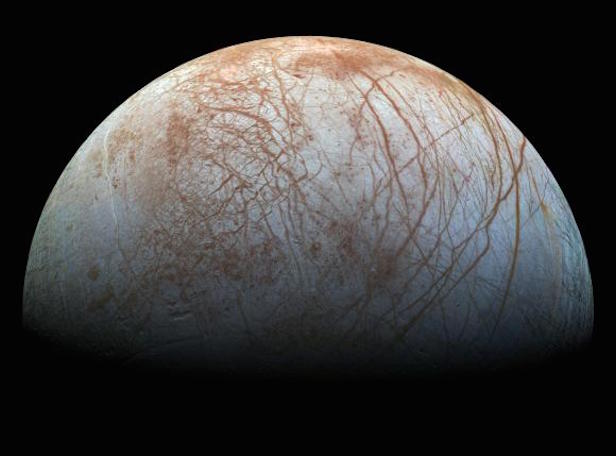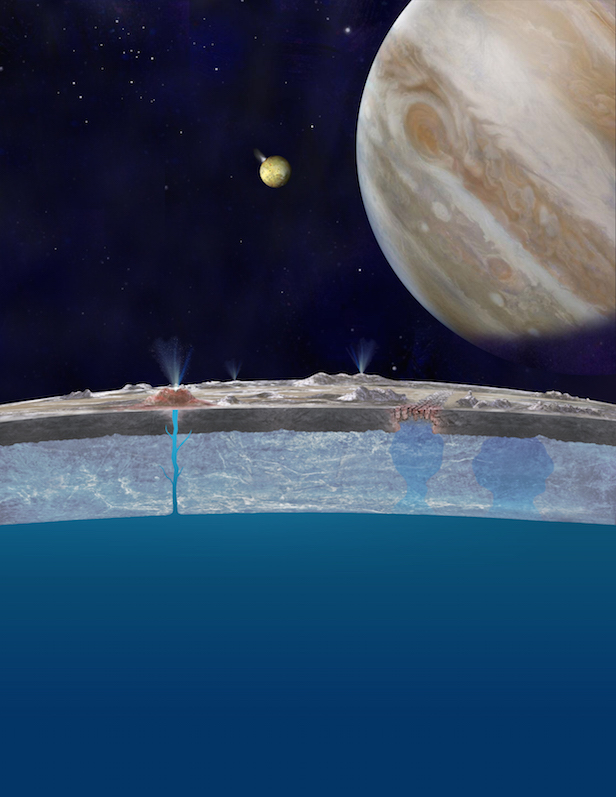More evidence arises for existence of Europa’s subsurface ocean
Computer modelling has shown a scenario that accounts for the surface subduction in the Jovian moon’s plate tectonics

Jupiter’s moon, Europa, has signs of plate tectonics visible on its surface with the presence of a series of cracks. Image credit: NASA/JPL-Caltech/SETI Institute
A study conducted by Brown University in the United States has provided more evidence that the icy surface of Jupiter’s moon Europa experiences similar plate tectonics to what we see on Earth. Plate tectonic activity is a strong indication that there is the presence of a subsurface ocean, which could have major implications for the possibility of life surviving beneath the icy surface.
By conducting a series of computer models, a team of researchers showed that subduction is physically possible on Europa’s surface. Subduction occurs when a tectonic plate slides underneath another and sinks into the planet’s interior. This work compliments the previous analysis of the moon’s geology, as there was regions discovered that showed the shell to be expanding in a way that resembles the mid-ocean spreading ridges on Earth.
“We have this evidence of extension and spreading, so the question becomes where does that material go?” says Brandon Johnson, an assistant professor at Brown University’s Department of Earth, Environmental and Planetary Sciences. “On Earth, the answer is subduction zones. What we show is that under reasonable assumptions for conditions on Europa, subduction could be happening there as well, which is really exciting.”
The surface composition also appears to be enriched with oxidants and other exotic chemicals that could fuel life. Subduction would allow these chemicals to interact with the ocean that resides under the moon’s outer layer, making it a viable place for life. Johnson also explains, “If indeed there’s life in that ocean, subduction offers a way to supply the nutrients it would need.”
On Earth, subduction is driven primarily by temperature changes between a descending slab and the surrounding mantle. The crust is much cooler than the mantle material, and not only that, but it is much denser as well. This density difference provides the negative buoyancy necessary to sink the slab into the mantle.

Europa has been a longstanding target for intense research, as its possible subsurface ocean could provide a favourable environment for life. Image credit: NASA/JPL-Caltech
Previous research on the geology of Europa has hinted that subduction could be possible, but it’s never been clear how a process like this could occur on an icy moon. There has been evidence supporting the idea that Europa has two layers to its icy shell. These two layers consist of a thin outer lid of extremely cold ice, underneath is a slightly warmer, convecting ice. In the subducting scenario, the plate would submerge into the warmer ice below, and the increased temperature would quickly warm it to the same temperature of the surrounding ice. This would cause the slab to have the same density, and therefore it would stop descending.
However, this study showed a way of subduction in Europa that could occur regardless of temperatures. The model showed that if there were varying amounts of salt in the surface, it could provide a density difference that would lead a plate to submerge.
“Adding salt to an ice slab would be like adding little weights to it because salt is denser than ice,” explains Johnson. “So rather than temperature, we show that differences in the salt content of the ice could enable subduction to happen on Europa.”
There’s good reason to think that there are variations in the salt content on Europa based on previous observations and data. There is evidence that there can be an occasional water upwelling from Europa’s internal ocean, which is similar to the upwelling of magma from Earth’s mantle. This upwelling could distribute high concentrations of salt across the crust of the icy moon. There is also the possibility of cryovolcanism, this mechanism could spray salt water all across the surface.
It is also believe that this work studying plate tectonics on Europa can also tell us about the evolution of our own planet. “It’s fascinating to think that we might have plate tectonics somewhere other than Earth,” Johnson says. “Thinking from the standpoint of comparative planetology, if we can now study plate tectonics in this very different place, it might be able to help us understand how plate tectonics got started on the Earth.”
Keep up to date with the latest reviews in All About Space – available every month for just £4.99. Alternatively you can subscribe here and make the most of our Christmas offer for a fraction of the price!




